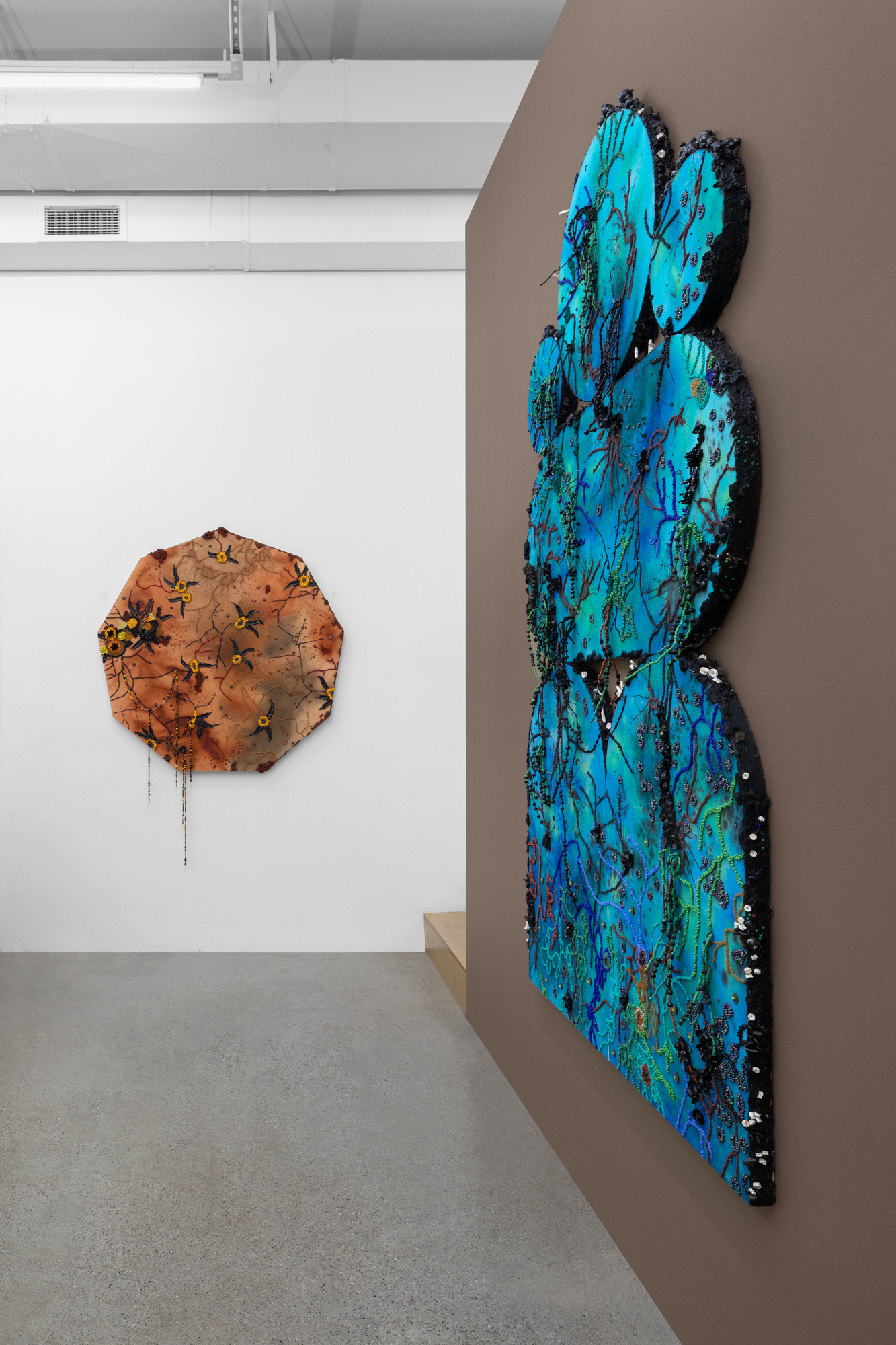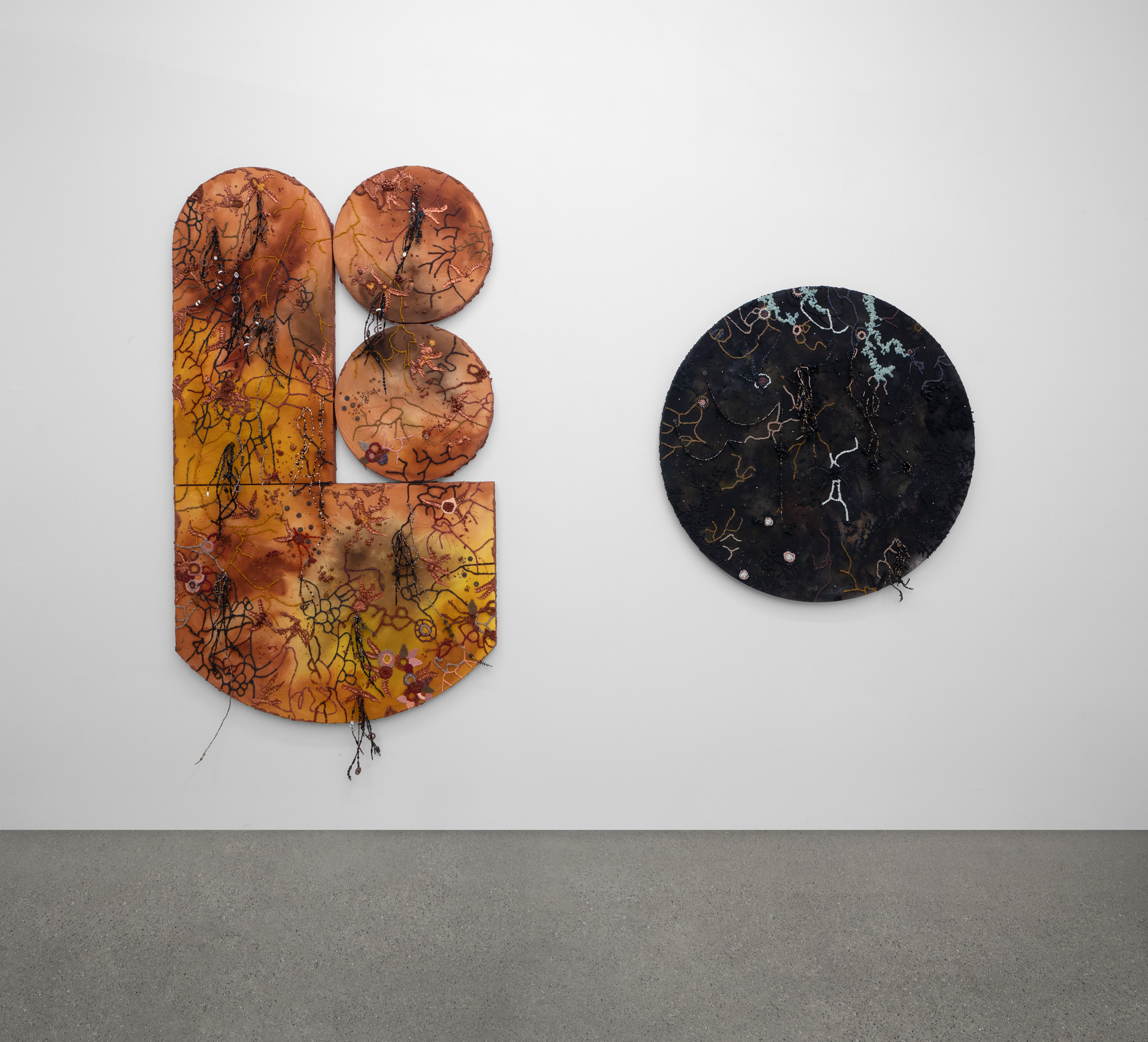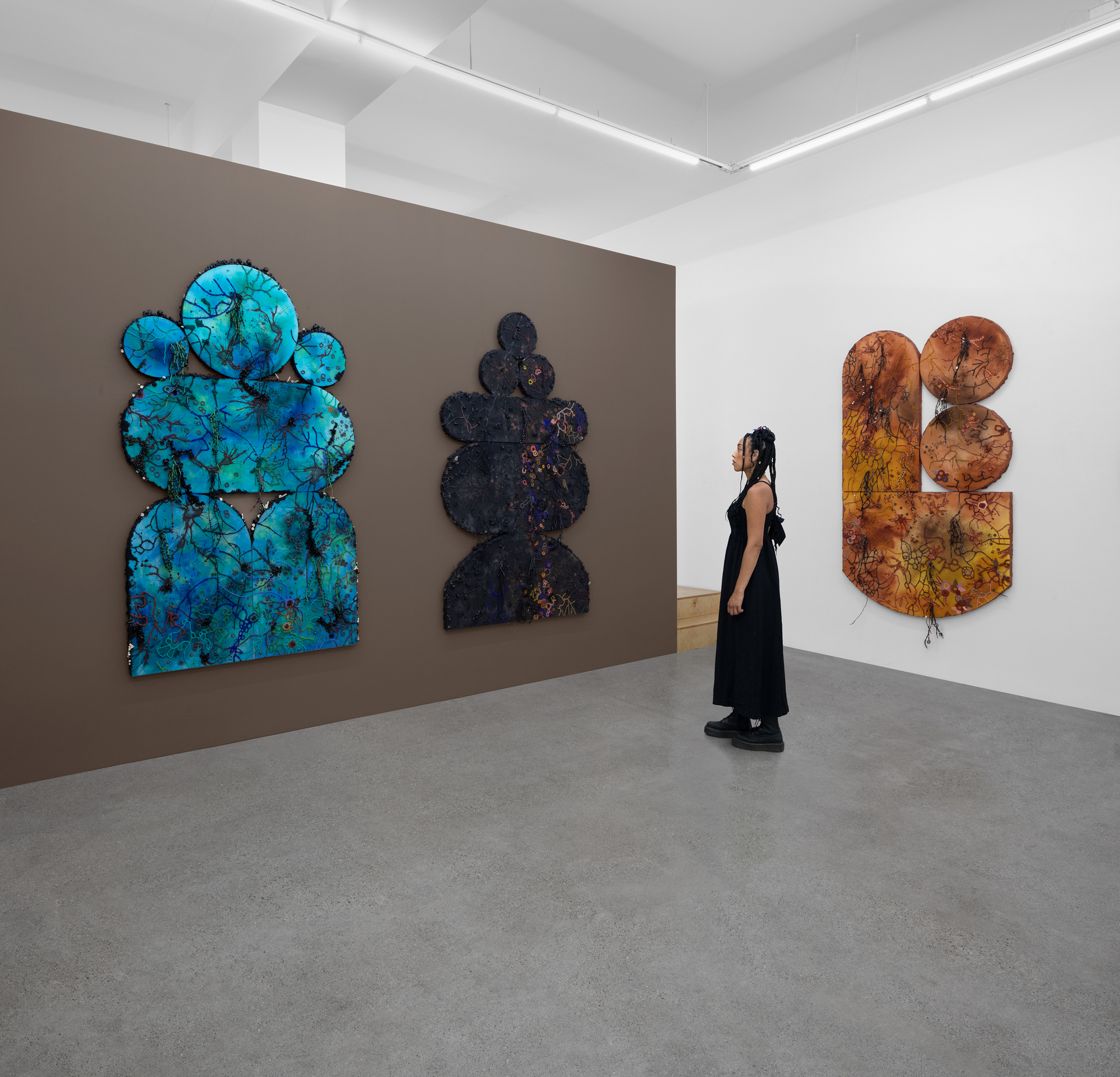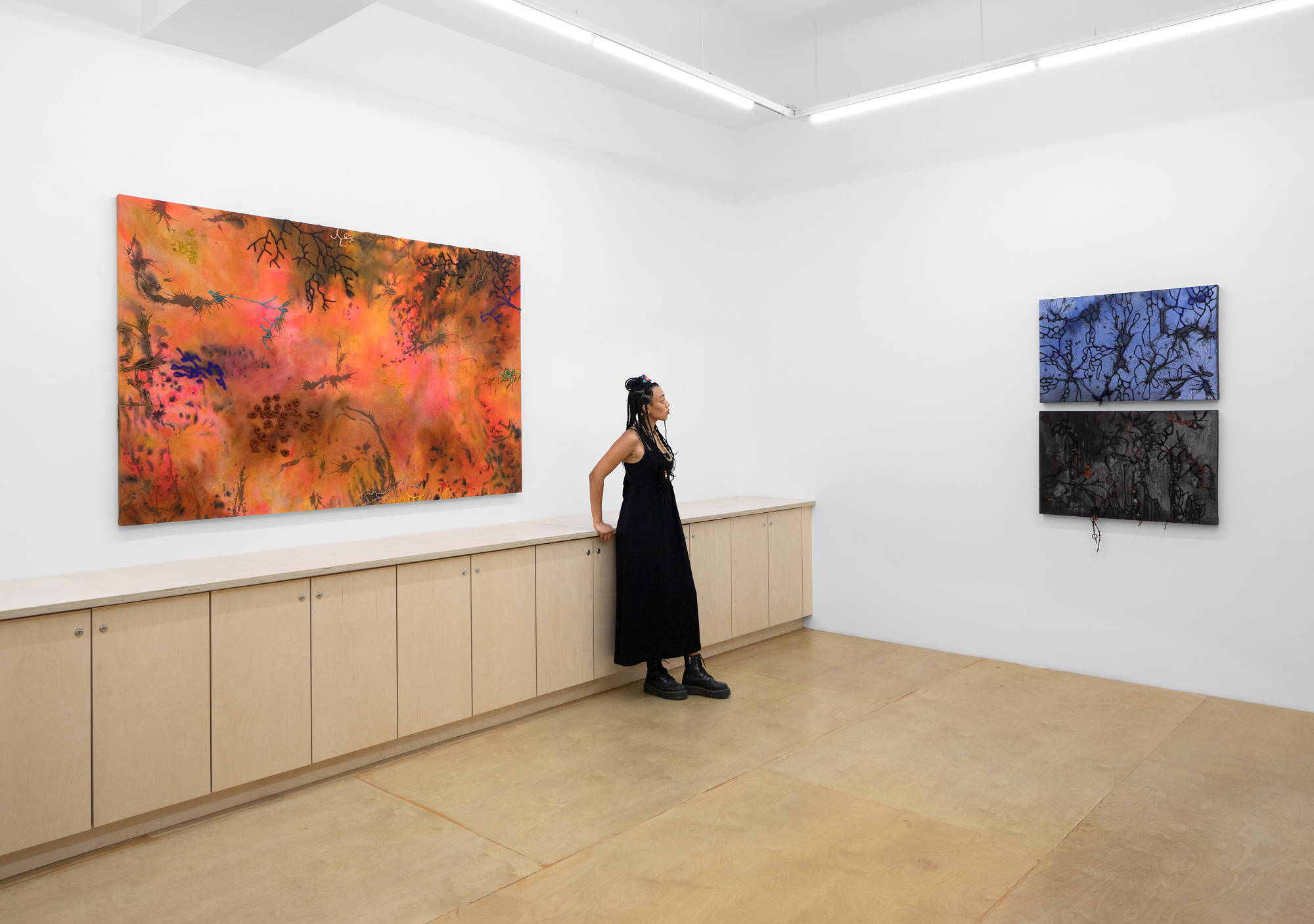
Ashley Cook
September 2, 2024

July 27th marked the opening of Olivia Guterson’s inaugural exhibition with Louis Buhl & Co. As a recent graduate from Cranbrook Academy of Art, the work in this show represents her transition from student to professional, starting this new chapter with an adventurous use of material and form. Guterson’s “offerings” manifest through deep listening and meditative communication between intuitive and inherited patterns that have been carried through time by her Jewish and African ancestors. Here, traditional cultural objects respond to the organic process of migration in ways that visually resemble the expansion of roots and the natural tendencies to reconverge after displacement. The artist’s curiosity about her own Jewish and African roots is illustrated through the wandering lines spread throughout the surfaces that breathe with irregular ombre. The figurative-esque stacks assume a presence that feels both familiar and alien, brand new and ancient. Like migrants who remain true to their heritage despite living in a cultural diaspora, the works in this show are both souls to engage with and places to go. Guterson recognizes the process of discovery to be the animating force that has thus far guided reconciliation with generational traumas and the chaotic world we live in today.
I had the opportunity to speak with Olivia Guterson about her life, her creative practice, and the work in the exhibition In the Wild Beyond...

A: Congratulations on earning your MFA in Painting from Cranbrook Academy of Art. Were you working with a similar approach while studying at there?
O: So this way of working is relatively new to my practice. In the first year at Cranbrook, I focused on creating black and white hand drawn patterns. The beads did not really come into the mix until my second year, and the stacked forms really did not start until the end of my time at the school. The first stacked form was presented as my graduate exhibition piece.
A: What is the creative process like for you?
O: The process of making work for me involves prayer and deep listening. I often think of it as a “call and response“ type communication between my conscious thoughts, subconscious thoughts, and the material. When I make work, my thoughts are very often circling around my heritage, contemplating the journeys of my ancestors that made it possible for me to be here now. My Jewish ancestors migrated to the US to escape persecution, and my African ancestors were brought to the US as enslaved people. The stacking forms pay homage to the Jewish tradition of stacking stones on the graves of our loved ones for way-finding but also as a way to show care for the deceased. The beads are something that I have grown up around, adorning my hair with them, and the patterns that I have been using for the past decade or so draws from the doilies and quilts of Jewish culture and the textiles of African cultures. I wanted to somehow develop my own pattern language and that is sort of where these pathways started to emerge.

A: There is a very wild way in which you create the lines. It is unpredictable where the line will go, which is interesting because it is almost like a break of pattern. For instance, you are using pattern, using your past, but somehow you are also rejecting it in some kind of way, maybe not consciously...in order to allow for a more organic reality to emerge. For example, your experience with the diaspora, and the migration of your family members. In moments of displacement, cultures stay strong but also have no choice but to open up their lifestyles and expectations to the unknown. So to me, that is what the work is communicating, informed by the writing, which provides information about your history.
O: Yes, I also often think about world building and world ending. Pathways of migration that form on the land are reflected in the lines of our hands, the roots of trees. The tendrils hanging down from the canvases and the crusts on their surfaces are meant to elicit ideas of expansion and growth. To your point, all of these have some kind of concern with place, and are also informed by the call and response techniques of negro spirituals as well as the embedded messages within those songs.
I do have these conceptual reasons for my decisions when making work, but I don’t necessarily need the viewer to know or understand all of those things. I love abstraction, and I work with abstraction, because I feel that it is accessible. I want people to receive what they need to from the work, but those details are available too, if people are interested.
A: Yes, I understand, you are not wanting to hide anything, but also not wanting to force feed people information. Do you happen to know the Detroit-based artist who goes by Spirituals? He had a show at MOCAD last year. That was his approach as well. He was avoiding being didactic by offering in depth information that is accessible yet not absolutely necessary to enjoy the work.
O: Yes, I think that is what art does best. I love the experience of being and becoming. I feel like as soon as we think we conclusively know something, we sort of shut the door to other possibilities. I mean, obviously going to graduate school, we were encouraged to incorporate research into our practice, and all of that is really important and valid, but at the end of the day, the world is crazy and chaotic and there is never just one way to see and experience something. I call my pieces “offerings” because they offer me a place to go to express myself in ways that I don’t have words for. I also want them to offer people a place to let their imaginations wander.
A: Aesthetically, its obviously very conscious that you are making the surfaces look aged, like its been outside and now has vines coming down or roots coming out of them. The materials on the sides resemble zebra muscles or barnacles. You were just talking about migration and the organic ways that life (and culture) travels from one place to another. Are you using the visual qualities of organic growth as a way to touch on that?
O: I often go to Ghana to visit my family. My partner is from there, and I have a four year old, so it is really important that we go back. I bought many of these beads from the markets, which are made by women there. I was able to form relationships with the people who made the materials, and that is really important to me. I also brought back the coconut shells, old trade beads, fish bones that are hand sewn on or embedded into the paint, sawdust or concrete on the surface. There are areas in the pieces where I applied watered-down paint and moved it around with my breath. I am really interested in documenting, time and life.
I think of the additive process of applying these materials in this way allows them to serve as protective elements, but again I am thinking about the growing over, the spilling over, the unruliness. The reason I call them “offerings”, and the reason that I am exploring the different shapes and combinations of canvases is because I want to imbue them with a role that exceeds the strict boundaries of painting. Adding the crust to them further allows for a space to occur that invites people to wander and imagine what it is. The nature-like look of the forms allow for the works to seem alive, and may not be the same tomorrow.
I attempt to play with this idea as well with scale. Since they are larger then human size, they hold significance in a way, and the fact that they are slightly figurative...
A: Yes, with the exhibition text referencing the mother and child. Each aspect’s ability to exist independently and also as part of the larger whole...
O: Yes, exactly.

A: I was curious when I was reading about your experience with the diaspora in the exhibition text if you can speak on that. There are so many generations now that have been affected by migration, living in the diaspora. Do you feel that from generation to generation there are differences in the way that you speak about it versus how your parents would speak about it, or your grandparents?
O: I am second generation on my Jewish side of the family, and I think the process of becoming American, assimilating can often lead to a lot of silence. I think also in the wake of mass tragedies like the Holocaust, there was just not a language to talk about it. In our time now, there is a lot more language and space for self-care, therapy and healing. I am a lot more open to asking questions and expressing curiosity about the history of my family then my own parents were. In seeking to understand my own relationship with place, I am also eager to understand other peoples relationship with place and the journey they took to get there.
I think about how dynamic survival is, beyond just getting by. I think acknowledging what has happened and how it led to generational traumas and generational curses can also lead to uncovering and acknowledging generational gifts...
A: Do you know where in Africa your family is from?
O: Mostly Cameroon, but I don’t have much of a connection to that history. I have recently tracked my African family back to a plantation though, so my plan is to go back to where the plantation was, make ceremony, listen to and collect soil samples, make pigments from the natural materials there, and develop a new body of work.
A: Do you know where your Jewish family is from?
O: Yes, kind of all over the place. Russia, Poland, Ukraine...I also feel like that would be very valuable for me to explore through my work, but I already have a lot more access to that side of my family’s language and rituals then I do the African side of my family.
A: So interesting, you have such a path of discovery ahead of you...
O: I am very grateful that I have a practice that allows for me to explore these themes that lead to deep meditation and learning.

In the Wild Beyond at Louis Buhl & Co. opened on July 27 and will be on view until September 4, 2024
https://www.louisbuhl.com/